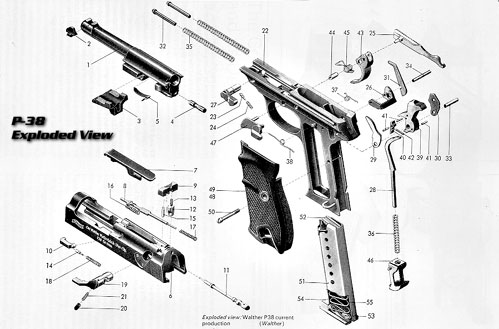
Walther P38 Pistol
物件資料提供:火器堂

Walther P38,原配發給高階軍官使用,後來狙擊手及戰車兵諸等也有配給; 於1938正式採用, 取代Luger P08的原因是較便宜,且生產容易。在戰時生產總數超過了一百萬把(一說這數據包含了鋁合金質材之戰後版)以上。
側面參考:發展歷史
Immediately before World War II, Walther moved further into the field of 9mm parabellum firearms by the introduction of a model HP and in 1937 the Heeres Pistole or service pistol was presented to the German officials. Finally in 1938 a modified HP was adopted by the military staff, along with the Luger, as the standard service sidearm and designated the P38 (pistol Model 1938). Test models of the HP were built in the caliber .38 ACP and .45 ACP for the American market and, in fact a commercial 9mm HP was marketed by Stoeger Arms of New York in 1939.
The P38 was adopted by the Arm in 1938. The main differences between it and the HP are, apart from the markings on the slide, the checkered wooden grips, the rectangular firing pin and a concealed extractor, making parts non-interchangeable. There were also a number of minor changes made in the P38 during its development.
The first series of Walther P38s during the war had serial
numbers beginning with an 0 and the first 1,500 of which have the rectangular
firing pin of the HP. There would seem to have been three types of markings
during the development on the basic gun, namely HP, P38, and Model P38. The
HP and the Model P38 have German commercial proof marks and are rare. The proof
mark was probably used for export or for police units. Also evident, as on other
wartime produced German weapons, were the manufacturers' code numbers. The P38
 was
manufactured by Walther, Mauser and Spreewerk. The codes used on the weapons
to conceal the producer's from the allies were as follows: Mauser bfy, svw;
Walther 480, ac; and Spreewerk cyq. As previously mentioned there were a number
of Walthers built which do not come into the general production runs. One of
these guns was not even assembled. This was a version of the P38 manufactured
by FN. No completed guns are known but the allied forces captured a large number
of receivers and slides when they moved into Belgium.
was
manufactured by Walther, Mauser and Spreewerk. The codes used on the weapons
to conceal the producer's from the allies were as follows: Mauser bfy, svw;
Walther 480, ac; and Spreewerk cyq. As previously mentioned there were a number
of Walthers built which do not come into the general production runs. One of
these guns was not even assembled. This was a version of the P38 manufactured
by FN. No completed guns are known but the allied forces captured a large number
of receivers and slides when they moved into Belgium.
One important warning, apart from the usual remarks regarding wartime production, is that the P38 can be assembled and fired without the locking block. This means that the weapon functions as a blowback one and consequently serious damage will occur as well as the obvious danger.
Production of the P38 stopped in 1945 and was resumed in 1957 for the Bundeswehr. A parallel prewar development was a hammerless version which was called the Armeepistole. This weapon was not produced in quantity as the German Command chose the P38; Walther stopped development and production of the Armeepistole to concentrate on the P38. The Armeepistole was made with light alloy components, long barrels and even shoulder stocks during its development.
When the post-war production of the P38 was resumed the weapon was made with very few modifications, although it must be noted that many post-war parts cannot be interchanged with those of the wartime production because of slight dimensional changes.
附註參考:零件價目表
|
基本諸元: |

|
|
| 口徑: | 9 mm | |
| 全長: | 21.59 cm | |
|
全重: |
964 gm | |
| 槍管長: | 12.07 cm | |
|
裝彈方式: |
插入式8發彈匣 | |
|
作業方式: |
阻礙式後座力作用 | |
|
閉鎖機: |
起落式楔形閉鎖塊 | |
|
生產廠商: |
||
| ac – Walther (Zella) | ||
| byf /svw – Mauser (Obernodorf) | ||
| cyq – Spreeweke (Berlin) | ||
| fnh – FN(Belgium) | ||
| jvd - Brno | ||
<大部概說:>


左圖為槍管與楔形閉鎖塊:上為閉鎖時,下為開鎖。 在後座力作用後退時, 壓迫推桿使閉鎖塊下落。 右圖顯示滑套上的閉鎖槽( Beretta 92與此相同。 )

大部分解型態;可見到P38是使用雙復進簧的,配置在槍身後方,左右兩側各一。(細部分解見上方槍主手冊)


這邊是擊錘彈簧;(退彈匣鈕也是使用相同彈簧。) 由一圓形鐵片規律"扳機"與"擊錘"的連續運動,可靠性佳。

三種不同的扳機機簧位置, 由左至右: 待擊時、 擊發時、 連動射擊時。

124 grain 的9 mm子彈。 使用標準的手槍用片狀發射藥, 燃燒較快。

8發裝單排彈筴,上開7個檢視孔,檢查筴內存彈用。

在滑套後上方, 在照門下, 有一小針, 在膛內有子彈時會突出, 作為警示。

槍機頭的上方為膛內有彈警示針, 中心為撞針, 右側為退子抓鉤, 左側為退殼器。 P 38退彈殼時向左方彈出
